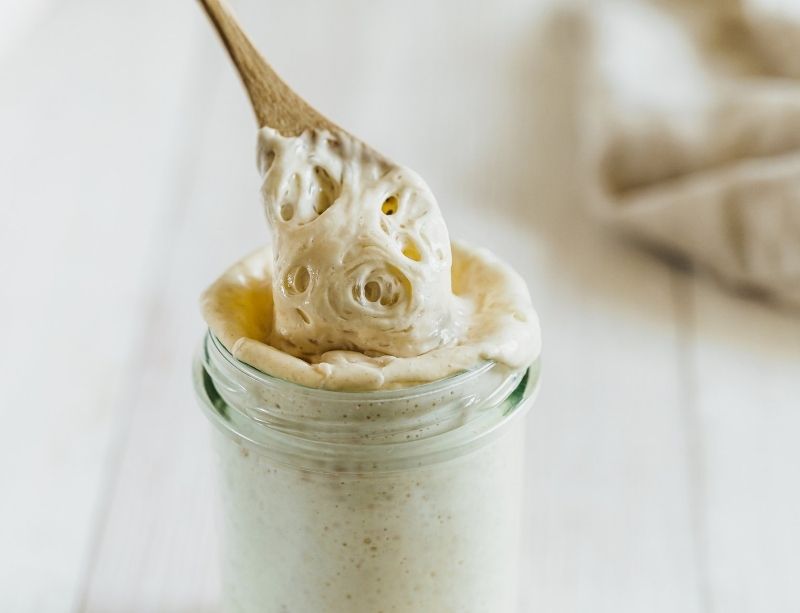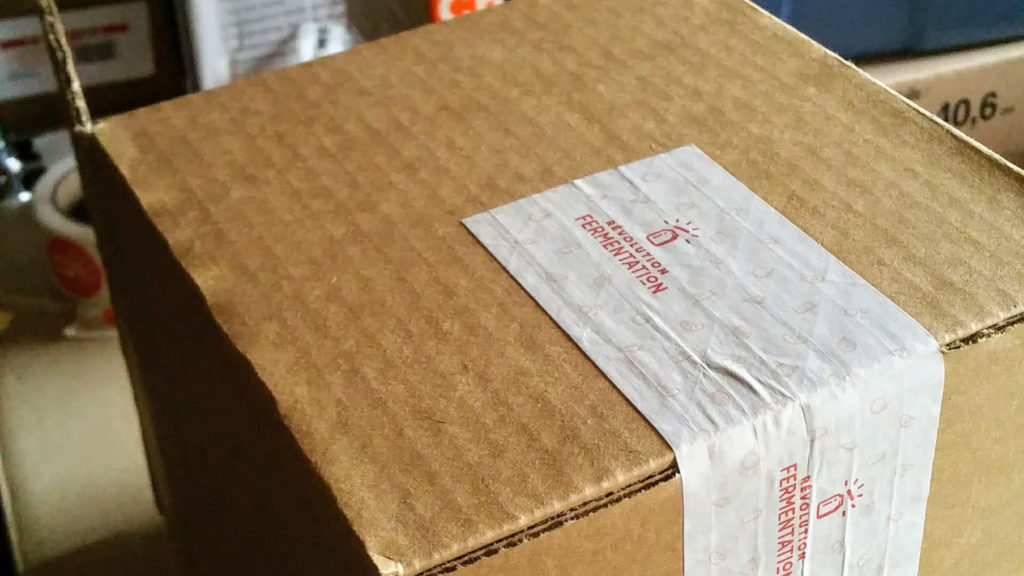Keeping your cultures healthy is the key to successful home fermentations!
This mini guide offers tips on how to extend the shelf life of various starter cultures, such as those used to make kombucha, milk kefir, tempeh, and many others…
In a nutshell, all cultures can be stored in the fridge. However, some also tolerate freezing, which can extend their shelf life. Read on to find out the best ways to store your cultures.
Go straight to the section that interests you:
- Why does cold help to preserve?
- Can starter cultures be stored at room temperature?
- How should starter cultures be stored?
- Can starter cultures be dehydrated?
What Is a Starter Culture?
A starter culture is a collection of microorganisms – bacteria, yeast, mould, or a combination of these – that are added to food to start fermentation (ref.).
For example, by adding a kombucha mother to sweet tea, you initiate kombucha fermentation!
Although some fermentations, such as lacto-fermentation, use bacteria already present on the vegetables, most fermentations require the addition of a starter culture to ensure successful transformation.
How Can Starter Cultures Be Stored?
In a household context, the options for storing starter cultures are the following:
- At room temperature: from a few days to a few weeks.
- Refrigeration: from a few weeks to a few months.
- Dehydration: riskier, but possible for a few months.
- Freezing: from a few months to a few years.
The choice of storage method and possible duration depends on the type of starter culture. Read on to find out more.
Can Starter Cultures Be Stored at Room Temperature?
Starter cultures are hardy enough to survive several weeks at room temperature, which makes it easier to ship them in non-refrigerated packages. Their loss of vitality is considered when determining the ‘Best Before’ date.
However, it is not advisable to keep your starter cultures at room temperature for more than 20 days. We also strongly advise against direct exposure to sunlight, as this will greatly accelerate the deterioration of the starter culture.
Why Does Cold Help Preservation?
Cold extends the life of food and microorganisms (ref. ref.).
By slowing down microbial and enzymatic activity, cold limits the growth of microorganisms and extends the shelf life of your precious starter cultures.
In concrete terms, at 25°C, microorganisms develop and multiply rapidly, but far less so at 2°C and virtually no longer at all at -15°C. The cold therefore slows down the aging process! It is sometimes said that microorganisms ‘go dormant’ thanks to the cold, i.e., they go into a state of low activity where their metabolism is reduced to a minimum.
Think of your fridge and freezer as ‘slow hotels’ for your starter cultures.
The lower the temperature, the longer they will keep. But beware, not all starter cultures can tolerate the cold of a freezer!
Can You Dehydrate Starter Cultures to Store Them?
Yes, it is perfectly possible to dehydrate certain starter cultures to extend their shelf life. For example, sourdough, water kefir, and milk kefir grains are often stored using this method. It is important to dehydrate quickly and keep the temperature below 42°C to avoid killing the starter culture. A temperature of 40°C in a ventilated dehydrator is generally ideal.
It’s worth noting that it’s a good idea to combine dehydration and refrigeration for longer storage.
However, it is important to note that dehydration can be riskier for the viability of the starter culture. For this reason, refrigeration or freezing are often considered safer storage methods.

How to Store Your Starter Cultures
The best storage method depends mainly on the type of microorganisms in your culture.
Here is a summary table of recommended storage methods for each type of starter culture:
| Type of starter culture | Storage method |
|---|---|
| Yeast | Fridge |
| Bacteria | Freezer |
| Moulds | Freezer |
| Mixed | Fridge |
| Enzymes | Fridge |
Ideal temperature:
- Fridge: 0 and 4°C (32 to 39°F)
- Freezer: -18°C (0°F), or less
To preserve your starter cultures well, it is recommended that you put them in the fridge!
That said, certain exceptions may apply depending on the packaging or strain you have. So always follow the manufacturer’s recommendations and, if in doubt, opt for refrigeration (ref. ref.).
Yeast
Yeast, which is used in alcoholic fermentations such as mead, wine, and cider, comes in several forms: dry, fresh, and liquid. Each form has its own advantages and disadvantages, as well as instructions for storage and use.
The following table shows three examples of storage for active dry yeast sold in sachets.
| Yeast | Storage |
|---|---|
| Lalvin D47 | Fridge |
| Lalvin EC-1118 | Fridge |
| Lalvin K1-V1116 | Fridge |
To guarantee their effectiveness, we recommend storing active dry yeast in a dry environment, between 4 and 15°C.
After opening, yeast shelf life decreases drastically. Exposure to air causes a rapid loss of activity. It is therefore preferable to use them all at once to ensure effective fermentation.
Bacteria
Freezing is recommended to prolong the freshness of bacteria, as bacterial cultures stored at 4°C (or higher) are vulnerable to faster depletion (ref.).
The following table gives specific recommendations for certain bacterial strains.
| Type of bacteria | Storage |
|---|---|
| Yogurt cultures (vegan, matsoni, viili) | Freezer |
| Caldwell’s Starter Culture | Freezer |
| L. Reuteri Superfood Starter | Freezer |
| Natto culture | Freezer |
Mould
Mould? In MY fermentations? 😮 That’s right, some fermentations, such as cheese, tempeh, or miso, are made using what we call moulds… noble moulds, naturally!
Mould spores tolerate very low temperatures. Therefore, temperatures of around -20°C are preferred (ref.). Now, you can be sure of how to store a tempeh starter!
| Type of mould | Storage |
|---|---|
| Tempeh culture | Freezer |
| Koji culture (miso, shoyu, amazake) | Freezer |
Mixed Starter Cultures
Mixed starter cultures are comprised of different types of microorganisms. A kombucha mother (SCOBY) is a good example: it contains yeast as well as bacteria.
So, how to store SCOBYS effectively? The best way to store mixed starter cultures is in the fridge. This advice also applies for storing milk kefir grains and storing water kefir grains. The following table shows several examples of mixed starter cultures.
| Type of starter culture | Storage |
|---|---|
| Dehydrated kefir grains (milk and water) | Fridge |
| Kombucha and jun SCOBYS | Fridge |
| Dehydrated sourdough (classic and gluten-free) | Fridge |
| Kefir powder culture | Fridge |
| Yogourmet yogurt culture (original and with probiotics) | Fridge |
Enzymes
Enzymes, used in the fermentation of food, such as bread, cheese, and alcohol, act as accelerators of specific chemical reactions in cells (ref.). They come in a variety of forms, including liquid and powder.
Enzymes are mainly stored in the fridge.
| Type of enzyme | Storage |
|---|---|
| Organic vegan rennet | Fridge |
| VitalKal enzyme culture | Fridge |
Frequently Asked Questions
How Do I Determine My Starter Culture “Best Before” Date?
The best way to determine your starter culture “Best Before” date is to rely on its label. Every commercially bought starter culture has one.
Cultures that you reuse, such as water kefir grains, milk kefir grains, and kombucha mothers, have a variable shelf life depending on the culture and the method of preservation used. Consult the guides for making water kefir, milk kefir, and kombucha to learn how to store these cultures.
Can Starter Cultures Withstand High Temperatures?
Starter cultures’ tolerance of high temperatures (35°C or more) depends largely on the type of microorganisms they contain. In general, we advise against exposing your cultures to high temperatures. Heat can accelerate the deterioration of the culture and reduce its vitality.
When Should I Dispose of My Culture?
A culture begins to weaken significantly once its “Best Before” date has passed. However, a “Best Before” date is not an expiry date. Therefore, it’s highly likely that your culture will still be working for a long time, but that it will be less vigorous.
To check whether your ferment is still working, make a small recipe by adding more culture and observe whether fermentation goes well.
How to Recognize a Contaminated or Spoiled Culture?
It is difficult to detect a contaminated or spoiled culture simply by looking at it. The best way to determine this is to make a small recipe. If the culture is no longer active, your preparation will be mouldy, have a bad smell, or have an abnormal colouring.
Conclusion
Refrigeration will prolong the shelf life of your starter cultures. The fridge is suitable for all cultures, but some can be frozen, which means they can be kept longer.
Proper storage of your ferments is crucial to maximize their effectiveness and benefits.

